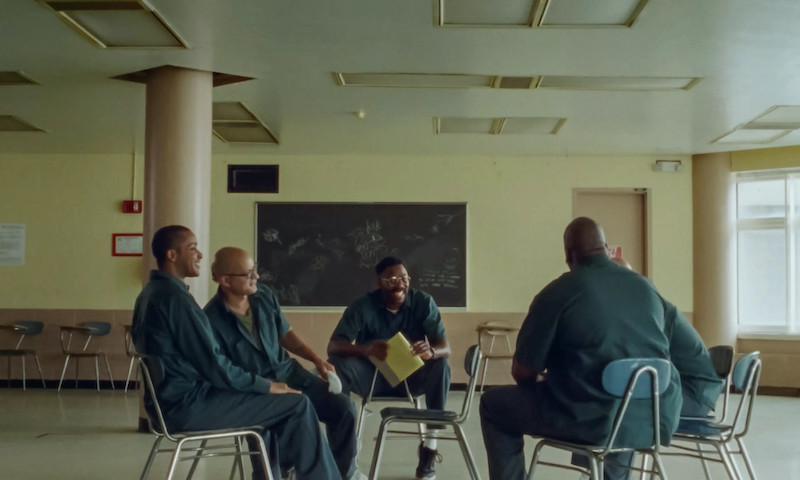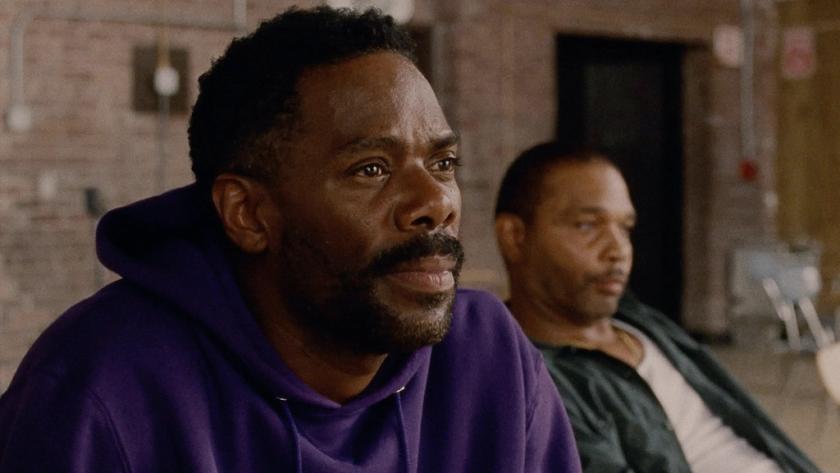Every actor has their own take on what acting means to them, which will include the chance to occupy personalities more interesting than their own, or to shed their inhibitions, or simply the pleasure of ‘play’.
A character in Sing Sing, an inmate who has joined the high security prison’s acting group, puts it more profoundly: “We’re here to become human again,” he cries, “to put on nice clothes and dance around and enjoy the things that [are] not in our reality.”
This stirringly atypical addition to the prison genre is largely about the power of art to change lives, in this case by introducing creativity, honest emotion, even hope into the lives of prison inmates – and, ironically, to release them from the roles they play to survive prison life, and express their true selves. The fact that it’s based on a real prison drama programme makes its message all the more persuasive and inspiring.
The film’s authenticity is marrow deep and worth relating. Rehabilitation Through the Arts (RTA) is a programme that started in the Sing Sing Correctional Facility, in New York state, in the 1990s, and encourages incarcerated men to put on plays, with remarkable consequences: while the rate in the US for people returning to prison is 60%, less than 5% of RTA participants follow the same pattern.
When filmmaking team Greg Kwedar (director and co-writer) and Clint Bentley (co-writer) learned of the RTA, they deep-dived into the subject, seeking out the programme’s former director, Brent Buell, a playwright and theatre director who had volunteered with the RTA program for more than 10 years, and two prominent alumni – John ‘Divine G’ Whitfield, and Clarence ‘Divine Eye’ Maclin. Whitfield and Maclin contributed to the film’s story, while Maclin makes an impressive film debut, playing himself. In all, 85% of the cast are former inmates, most of whom took part in the RTA.
 At the centre, though, is the glorious old pro Colman Domingo (pictured left), who is currently enjoying a run of rich roles (The Color Purple, Rustin) and reiterating his talent with each. He has something of Morgan Freeman about him: I don’t mean simply that they’re both African American, and Freeman starred in the definitive prison movie, The Shawshank Redemption; rather, Domingo has the same richly textured diction as Freeman, and the same gravitas, the kind that simultaneously anchors and makes soar any scene he’s in.
At the centre, though, is the glorious old pro Colman Domingo (pictured left), who is currently enjoying a run of rich roles (The Color Purple, Rustin) and reiterating his talent with each. He has something of Morgan Freeman about him: I don’t mean simply that they’re both African American, and Freeman starred in the definitive prison movie, The Shawshank Redemption; rather, Domingo has the same richly textured diction as Freeman, and the same gravitas, the kind that simultaneously anchors and makes soar any scene he’s in.
Domingo plays Divine G, convicted of a murder he didn’t commit, who seems intent on filling every waking moment with creativity and positivity – whether writing novels that are distributed around the country’s prisons (look out for the autograph hunter near the start of the film, who is the real Whitfield), helping colleagues with their parole hearings, or serving as the leading light of the RTA. For every moment of actorly exuberance, Domingo offers another whose intricacy and nuance reminds us of the quiet pain felt by a man who knows he has so much to offer, somewhere else.
We immediately experience Whitfield’s pomp as he recites a speech from A Midsummer Night’s Dream, Shakespeare not being beyond the talents of this incarcerated troupe. With that show a success, the group move onto the next. But first, they need new recruits; and they’ve had a surprising application. Divine Eye is a prison drug dealer and a forbidding loner; but he can also quote from King Lear. How can they refuse?
They also need a new play. It’s the newbie who wonders why they’ve never done a comedy (the filmmakers forgetting that in the Shakespearean canon, Midsummer is in fact a comedy). Buell (Paul Raci) sets out to write one that will accommodate all their wishes – for Egyptians, cowboys, Shakespeare, Freddy Krueger and much more – by wrapping it all in a madcap time travelling story. And so they get to work on Breakin’ the Mummy’s Code.
Dramatically, the film centres on Maclin’s slow thaw – the need for him to let go of his preconceptions, his tough guy image, his inherent distrust. The end game is to free himself from a lifetime’s stereotyping as “gangster”; if he can’t see that he deserves a second chance on the outside, no-one will.
 The play is his opportunity, and the rehearsals offer many of the film’s most insightful and touching moments. After one successful exercise, in which the director has encouraged his players to reveal something honest and tender of themselves, Buell comments: “Real, and vulnerable, something men don’t get to do, too often.” The straight to camera auditions – each man pitching for his chosen role – are a hoot. And the camaraderie and sheer joy in acting that they convey is infectious. By all accounts, the RTA has produced a host of fine acting talent, and the screen debutants here are first rate.
The play is his opportunity, and the rehearsals offer many of the film’s most insightful and touching moments. After one successful exercise, in which the director has encouraged his players to reveal something honest and tender of themselves, Buell comments: “Real, and vulnerable, something men don’t get to do, too often.” The straight to camera auditions – each man pitching for his chosen role – are a hoot. And the camaraderie and sheer joy in acting that they convey is infectious. By all accounts, the RTA has produced a host of fine acting talent, and the screen debutants here are first rate.
Other than first night, there are other deadlines on the horizon: Maclin’s parole meeting and Whitfield’s attempt to prove his wrongful conviction. Their fates become interlinked, but the exuberant thesp and the brooding self-styled gangster take a while to reach an understanding. The key moment comes during their edgiest encounter, when the older man insists on a correction in the other’s language: “We don’t use nigger in here, we use beloved. You feel me on that?”
Some may feel that the film is light on the harsher realities of prison life, at least as it’s always presented to us – the violence, constant threat and aggression. But Kwedar and Bentley achieve this more subtly, with less melodrama than the norm but plenty of pathos: our first, disturbing glimpse of Maclin in his alpha predator mode; Whitfield sweetly feeding some birds in the yard, only to launch himself onto the ground the instant the siren sounds, a sad example of prison conditioning; his barely controlled dismay as his cell undergoes a routine search, his beloved books and notebooks needlessly turned upside down; the men sitting on the grass looking over the Hudson River, or at the trains that run by (Sing Sing is actually cut in half by a railway track), going to places they will never see. There are numerous instances of broken dignity, regret, a resigned absence of hope.
The film was shot on location, using Sing Sing exteriors, with interiors shot in a nearby, now unused prison. Kwedar’s direction has a no-nonsense directness and immediacy that suits his unusual cast. Together they’ve created an enormously affecting piece; while the RTA has been taken up by some other US prisons, there’s a lesson here that ought to become universal.














Add comment